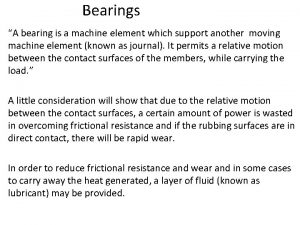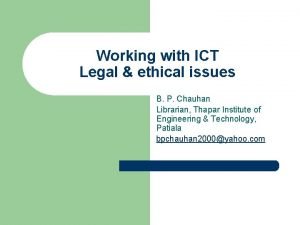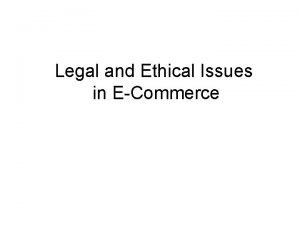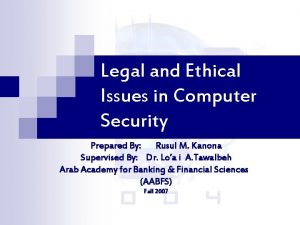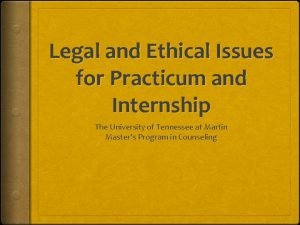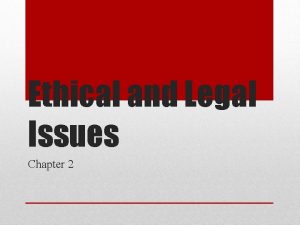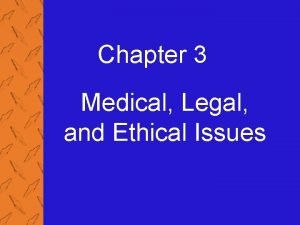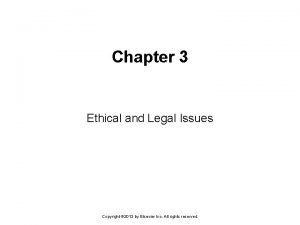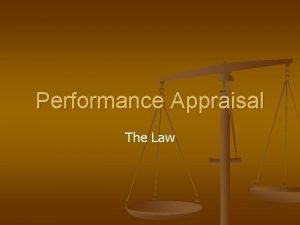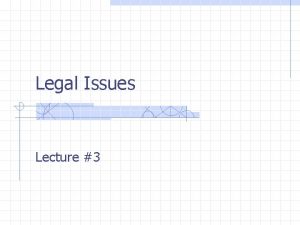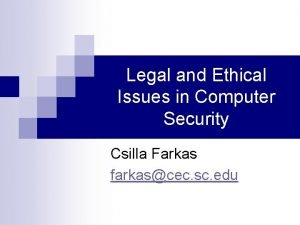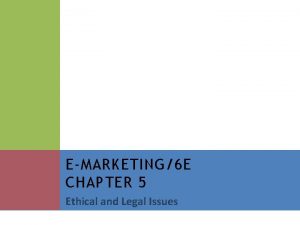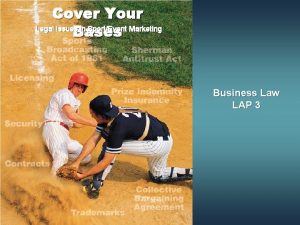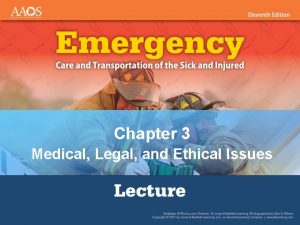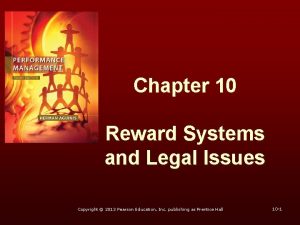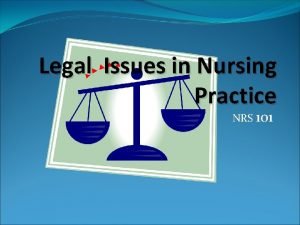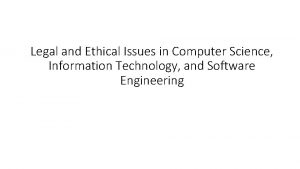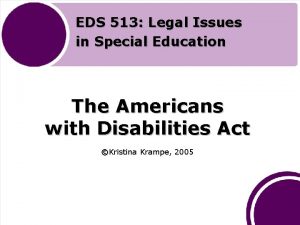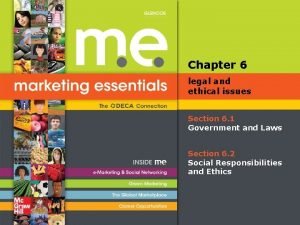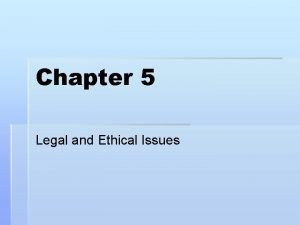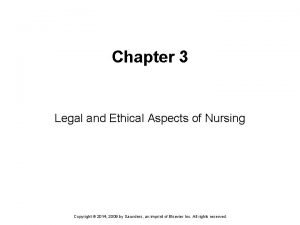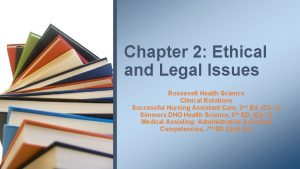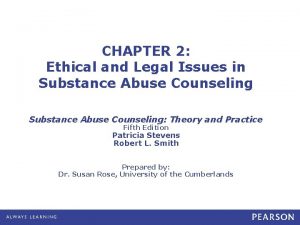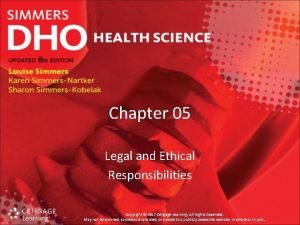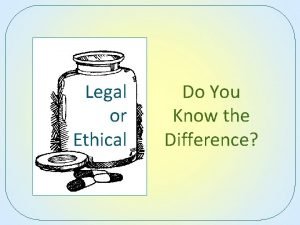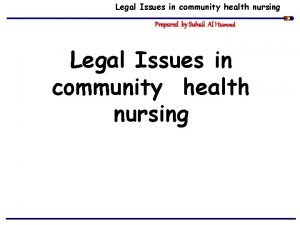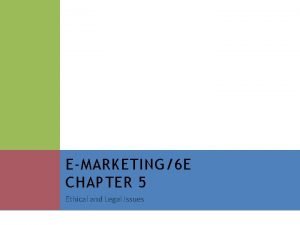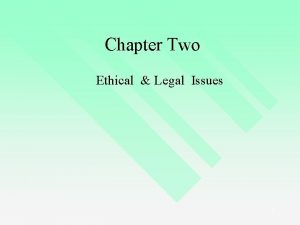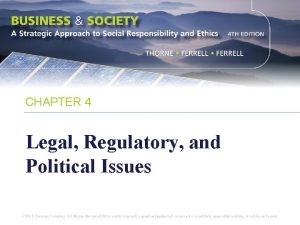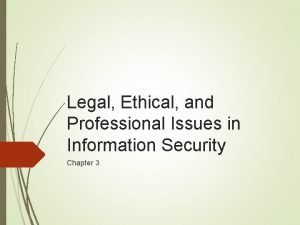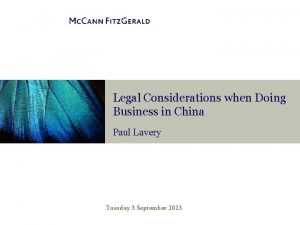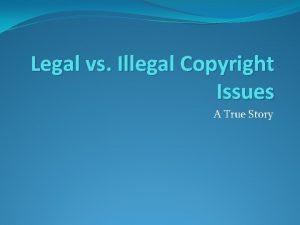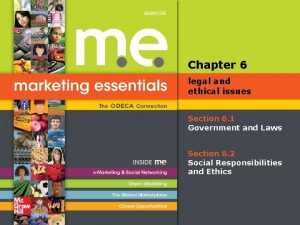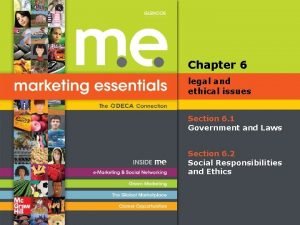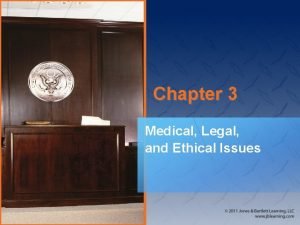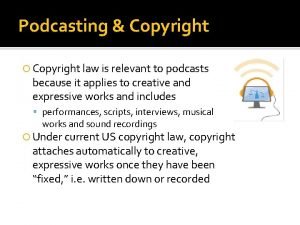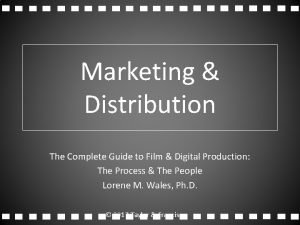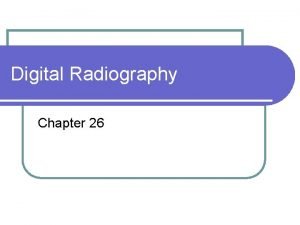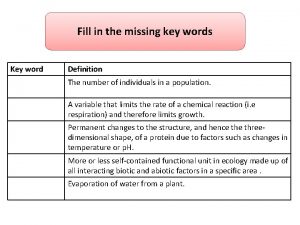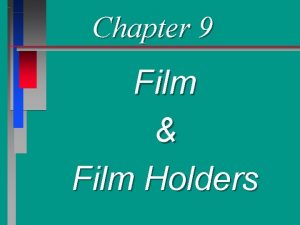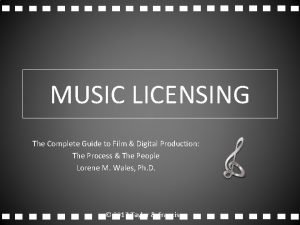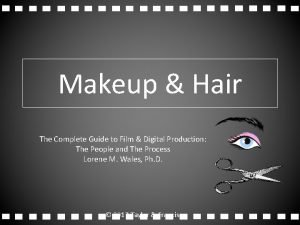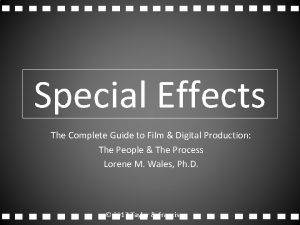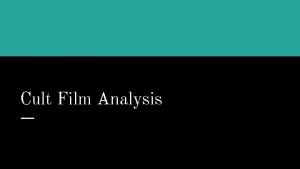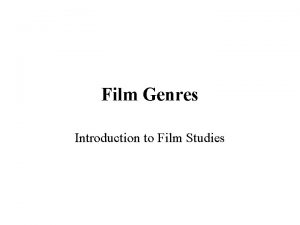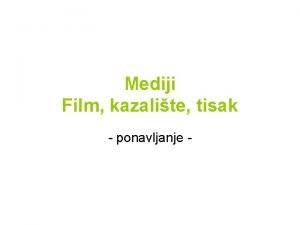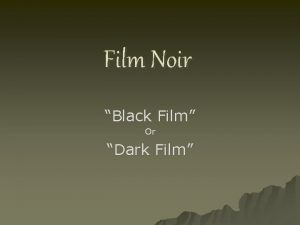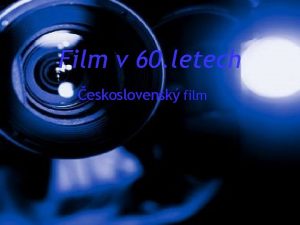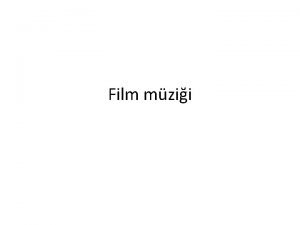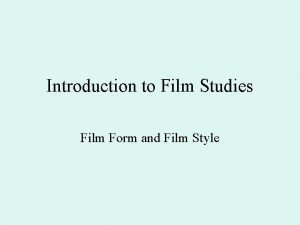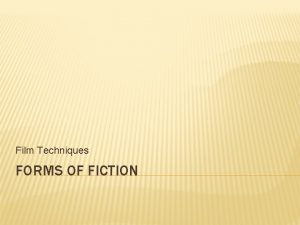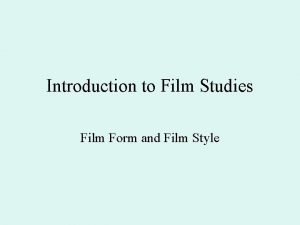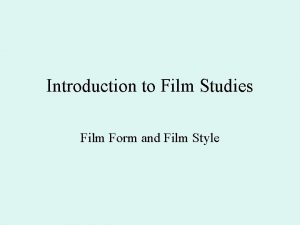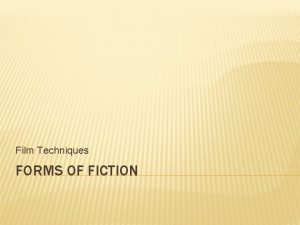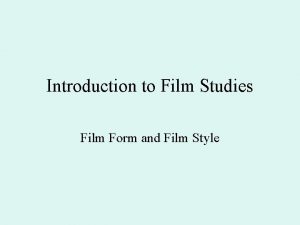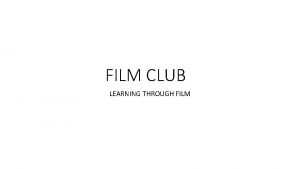LEGAL ISSUES The Complete Guide to Film Digital





















































































- Slides: 85

LEGAL ISSUES The Complete Guide to Film & Digital Production: The Process & The People Lorene M. Wales, Ph. D. © 2017 Taylor & Francis

Types of Intellectual Property üPatents üTrademarks üCopyrights üUnfair Competition üTrade Secrets © 2017 Taylor & Francis

Types of Patents üUtility üPlant (literally, agriculture) üDesign © 2017 Taylor & Francis

Utility Patent ü Any new and useful process, machine, composition of matter, or any new and useful improvement thereof, may obtain a …(35 U. S. C. § 101) © 2017 Taylor & Francis

Design Patents ü Whoever invents any new, original, and ornamental design for an article of manufacture may obtain a patent. (35 U. S. C. § 171) © 2017 Taylor & Francis

What Is A Patent? ü Grant by the U. S. Government to provide individuals legal protection for their discoveries (inventions). ü Gives the owner the right to prevent others from making, using or selling the invention. © 2017 Taylor & Francis

Life & Duration üUtility patent ü 17 years from date of issue if application filed before June 95 üor 20 years from date of filing application after June 95 üEffective only in the U. S. (foreign patent applications filed separately). © 2017 Taylor & Francis

Requirements for a Patent ü To obtain a patent, the new invention must be: üNovel – not known or used in this country and not published anywhere. üNonobvious – cannot be an obvious way to do something. üUseful – must have some application, even if not commercially practical. © 2017 Taylor & Francis

Trademar k Law Trade & Service Marks © 2017 Taylor & Francis

Trademarks & Names üIdentifies a tangible good or product of a company or individual. ü Trade names ü Once a trade name was used to denote any mark descriptive of a good or service. ü Today, it is a company business name. © 2017 Taylor & Francis

Trademark ü Any word, phrase, symbol, design, sound, smell, color, product configuration, group of letters or numbers, or combination of these, adopted and used by a company to identify its products or services, and distinguish them from products and services made, sold, or provided by others ü A distinctive mark, device, or implement that a manufacturer stamps, or prints on its goods. © 2017 Taylor & Francis

Trademark ü Assists customer in identifying a product without confusion. ü If a business uses the trademark of another, consumers are misled as to who made the goods. © 2017 Taylor & Francis

Trademark What can be trademarked ü Words that are used as part of a design or device or words that are uncommon or fanciful may be trademarked. What cannot be trademarked ü Personal names, descriptive or generic words, or place names ü Books ü Pencils ü Carper ü Hawaii © 2017 Taylor & Francis

Ownership and Registration ü First person to use a mark in trade owns it. ü Registration is not necessary, but does have some advantages. ü Protection becomes nationwide ü Gives public notification of trademark protection ü Damages under the Lanham Act are higher ü Holders of registered marks have first priority to use the mark as an Internet domain name © 2017 Taylor & Francis

Requirement of Enforcement ü An alleged infringer may claim that the Plaintiff's mark was abandoned and thus the protection lost. üNon use of the mark in question. üIntent to discontinue the use of the mark. üPresumptive abandonment occurs after two consecutive years of non use. üMay be rebutted by proof of intent to resume use. © 2017 Taylor & Francis

Service Mark ü Any word, name, symbol, device, or any combination, used, or intended to be used, in commerce, to identify and distinguish the services of one provider from services provided by others, and to indicate the source of the services. © 2017 Taylor & Francis

Domain Names ü Internet addresses, (domain names), were originally assigned with no cost. ü Now, bought and sold – sometimes for a lot of money, and sometimes sold by people who originally registered those names for free. ü If a domain name infringes on a registered trademark, the domain name will be suspended immediately if the trademark owner challenges it. © 2017 Taylor & Francis

Additional Concepts ü Product disparagement or product defamation. ü False statement about a product or company ü Must prove actual malice (companies are considered public figures) ü Must prove damages © 2017 Taylor & Francis

Additional Terms & Concepts ü Palming Off: One company sells its products by leading buyers to believe it is the product of another company. ü Gray Goods: "A gray-market good is a foreignmanufactured good, bearing a valid United States trademark, that is imported without the consent of the United States trademark holder. " © 2017 Taylor & Francis

Other forms of IP © Copyright © 2017 Taylor & Francis

Copyrights ü Copyright law protects the expression of an idea. Not the idea itself. ü Copyright protects ü “…original works of authorship fixed in any tangible medium of expression, now known or later developed, from which they can be perceived, reproduced, or otherwise communicated, either directly or with the aid of a machine or device. ” (17 U. S. C. § 102) © 2017 Taylor & Francis

Original ü The term original in the copyright law means that the work originated with the author. ü There is no requirement for novelty or uniqueness as there is in patent law. ü Must originate with author. © 2017 Taylor & Francis

Fixed in a Tangible Medium ü Any stable medium that will record or reproduce the material is acceptable ü Computer software satisfies the fixation the moment the material is stored (saved) ü A computer display is considered fixed even if it appears momentarily and only returns under certain conditions (games) © 2017 Taylor & Francis

Duration ü Depends on whether it is pre or post 1 Jan. 1978 ü Pre - Depends on whether published? Registered, first term, renewal etc. ü Post - ü Life of author + 70 years ü Work-for-hire 75 years from publication, 100 years from creation which ever is first © 2017 Taylor & Francis

Infringement ü To prove a violation, the plaintiff must show that the work was original, and that either: ü The infringer actually copied the work, or ü The infringer had access to the original and the two works are substantially similar. © 2017 Taylor & Francis

Infringement üA court may: ü Prohibit further use of the material ü Order destruction of infringing material ü Require infringer to pay damages © 2017 Taylor & Francis

Ownership ü Works for Hire - employer is considered the author when: üWork prepared by an employee within the scope or his/her employment. üWork specially ordered or commissioned for use as a contribution to a collective work. üDuration 75 years from publication or 100 from creation. © 2017 Taylor & Francis

Ownership cont. . üJoint Works - when 2 or more people make contributions of authorship with intention contributions be merged into inseparable work © 2017 Taylor & Francis

Public Domain? ü How can you tell if a work is in the public domain? ü Take a look at the following chart and you will see that it depends on when the work was created… © 2017 Taylor & Francis

© 2017 Taylor & Francis

Public Domain ü If published before 1923, it’s in the public domain. ü If it’s NOT in the public domain you cannot… ü ü ü Reproduce the music or lyrics Distribute (includes non-profit) Perform it in public Play it in public Make a derivative work Check out this website: www. pdinfo. com, an awesome website for everything PD! © 2017 Taylor & Francis

Video Games ü Copyright law protects the entirety of the computer code that creates the game in the same manner as it protects the entirety of a novel. ü Copyright law also protects the music, dialogue, scene and setting images, and character images within the game. © 2017 Taylor & Francis

Video Games- Player Licenses ü Licenses player to use the game within the terms that are set forth in the license. ü Does allow purchasers to make backup copies for purposes of archiving and re-loading in event of a computer crash ü Licenses to players may differ from game to game. Some permit or even encourage users to record and distribute screen shots of their plays. © 2017 Taylor & Francis

Plots and Concepts ü Basic game concept or plot is not protected by copyright law. ü Game designers are free to design new games based on these plot concepts, provided that the characters, art and words are substantially different from other games. © 2017 Taylor & Francis

Open Source and Creative Commons ü Some choose to license their games as open source or Creative Commons works. ü Allow the public to make designated use or some kinds of changes to the game. ü Creative Commons licenses can set out different kinds of authorizations, allowing others to make new games based on characters or producing t-shirts or other commercial products provided the original copyright holder is identified on subsequent works. © 2017 Taylor & Francis

Fair Use - Criteria Fair use is a law, which allows people to have certain use of certain copy written works, depending on the following four criteria. ü Purpose of the use (commercial or private) ü Nature of the work ü Amount of the portion used ü Effect of the use on the value of the original © 2017 Taylor & Francis

Purpose of the Use Issue: whether the material has been used to help create something new or merely copied verbatim into another work. ü ü Has the material you have taken from the original work been transformed by adding new expression or meaning? Was value added by creating new information, new aesthetics, new insights, and understandings? © 2017 Taylor & Francis

Purpose - Parody ü In a parody, the parodist transforms the original by holding it up to ridicule. © 2017 Taylor & Francis

Purpose of the Work ü Transformative is determined by: üWhether and to what extent it is “transformative, ” altering the original with new expression, meaning, or message. ü The more transformative the new work, the less will be the significance of other factors, like commercialism, that may weigh against a finding of fair use. © 2017 Taylor & Francis

Purpose of the Work üOK for purposes such as: üscholarship üresearch üeducation May also qualify as transformative uses because the work is the subject of review or commentary. © 2017 Taylor & Francis

Nature of the Work ü Because facts or information benefits the public: üYou have more leeway to copy from factual works such as biographies than you do from fictional works such as plays or novels. © 2017 Taylor & Francis

Published Works ü You have a stronger case of fair use if you copy the material from a published work than an unpublished work. ü The scope of fair use is narrower for unpublished works because an author has the right to control the first public appearance. © 2017 Taylor & Francis

Amount of the Portion Used ü The less you take, the more likely that your copying will be fair use. ü Your copying will not be a fair use if the portion taken is the “heart”. ü More likely to run into problems if you take the most memorable aspect of a work. ü For example, it would not be fair use to copy the opening guitar riff and the words “I can’t get no satisfaction” from the song “Satisfaction. ” © 2017 Taylor & Francis

Amount and Parody ü This rule — less is more — is not necessarily true in parody cases. ü A parodist is permitted to borrow quite a bit, even the heart of the original work. ü Supreme Court has acknowledged, ü“the heart is also what most readily conjures up the [original] for parody, and it is the heart at which parody takes aim. ” © 2017 Taylor & Francis

Effect of Use on Value of Original ü If the use deprives the copyright owner of income or undermines a new or potential market. ü Depriving a copyright owner of income will trigger a lawsuit. © 2017 Taylor & Francis

Effect of Use & Parody ü It’s possible that a parody may diminish or even destroy the market value of the original work. ü That is, the parody may be so good that the public can never take the original work seriously again. © 2017 Taylor & Francis

Parody and Fair Use As one judge explained: “The economic effect of a parody with which we are concerned is not its potential to destroy or diminish the market for the original —any bad review can have that effect—but whether it fulfills the demand for the original. ” © 2017 Taylor & Francis

Fair Use and the Courts ü U. S. Copyright Law cites examples of activities that courts have regarded as fair use. These include: üquotation of excerpts in a review or criticism for purposes of illustration or comment üquotation of short passages in a scholarly or technical work, for illustration or clarification üuse in a parody of some of the content of the work parodied © 2017 Taylor & Francis

Fair Use and the Courts (cont. ) ü summary of an address or article, with brief quotations, in a news report ü reproduction by a library of a portion of a work to replace a damaged copy ü reproduction by a teacher or student of a small part of a work to illustrate a lesson ü reproduction of a work in legislative or judicial proceedings ü reproduction, in a newsreel or broadcast, of a work located in the scene of an event being reported © 2017 Taylor & Francis

Acknowledging Source Material ü Acknowledgment of the material may be a consideration in fair use, but it will not protect against a claim of infringement. ü In some cases, acknowledgments can backfire and create claims, such as violation of the right of publicity. ü When in doubt, seek the permission. © 2017 Taylor & Francis

Disclaimers ü A disclaimer is a statement that “disassociates” your work from the work that you have borrowed. ü In close cases, a prominently placed disclaimer may have a positive effect on the way the court perceives your use. ü However, generally a disclaimer by itself will not help. © 2017 Taylor & Francis

Clearances ü The process of getting permission to use or refer to certain items. ü What items? © 2017 Taylor & Francis

Clearance Items ü Business names – If you refer to say, Mc. Donald’s a nationally known company, you need to get their permission. ü Product names – If you refer to an Oster blender, you may need to get their permission. © 2017 Taylor & Francis

More Clearance Items ü Organization names – If you refer to the Salvation Army you need to get their permission. ü Fine artwork – If you show a painting that’s on the wall, you need to get permission of the artist. © 2017 Taylor & Francis

More Clearance Items ü Photographs - You must get permission of the photographer and in some cases the people in the photograph (unless deceased). ü Book covers - Not if you film a whole library, only if the book is featured in a scene. © 2017 Taylor & Francis

More Clearance Items ü Magazine covers – again, really only if featured in a scene. ü Newspapers – this is why you see a lot of “fake” newspapers in film, it’s much easier to make a fake one than to get permission. © 2017 Taylor & Francis

More Clearance Items ü Wallpaper – Yes, wallpaper is art work, SOMEONE designed it didn’t they? ü Bedding – This mostly refers to quilts which is a major art industry. © 2017 Taylor & Francis

More Clearance Items ü Copyrighted Material – Goes without saying… ü Trademarked material – You don’t always have to clear trademarks, but it is a good idea. © 2017 Taylor & Francis

More Clearance Items ü Stock footage – This usually becomes “cleared” when you buy it, because you buy the rights for it, when you buy it. ü Film & TV clips – Same as stock footage. © 2017 Taylor & Francis

More Clearance Items ü Derogatory references – Being derogatory could subject you to charges of defamation or slander. ü Telephone numbers – This is why you hear “ 555” whenever actors mention a phone number. © 2017 Taylor & Francis

More Clearance Items ü Portrayals of famous people or government officials. ü Cases where filmmakers used look-a-likes &got into trouble, and some didn’t. ü Public figure is different because most public figures give up their right to privacy when they become famous, although that’s debated consistently by, guess who, the famous people! ü It’s all very gray… © 2017 Taylor & Francis

Releases ü A release is a person granting you permission to film their likeness or use their location, or use their material. ü Talent Release ü Crowd Releases ü Location Releases ü Script Release © 2017 Taylor & Francis

Important? ü Distributor or network, or cable channel will ask for “deliverables. ” ü Documentation from your film. ü Without these the company cannot air or distribute your film. © 2017 Taylor & Francis

Deliverables ü Can contain contracts, clearances, releases, post-production materials and credit information. ü This is done to insure you have all the proper legal permissions in place. © 2017 Taylor & Francis

Talent Releases üTwo kinds üAdult - 18 years old and over üMinor – 17 years old and under © 2017 Taylor & Francis

Minor Release ü Used for children 17 years old and younger. ü Because a minor is not legally allowed to sign a contract, the parent signs this one. © 2017 Taylor & Francis

Crowd ü When you are filming a large population of people, most often in a venue that requires a crowd, like a stadium, congregation, etc. ü The release is displayed in the area of filming in a place that is easy to see (generally a big sign). © 2017 Taylor & Francis

Location ü An agreement where the owner of a property agrees to let you film at their location. ü The agreement also promises that if you damage the location, you will pay for it. © 2017 Taylor & Francis

Script Release ü A contract between you and the scriptwriter. ü The release grants the production company the right to film the script. ü A script agreement is different than a script release. ü A script agreement is done when there is significant pay involved. © 2017 Taylor & Francis

Script Release ü Part of this release also allows the producer certain rights to the story. 1. ASSIGNOR sells, grants, assigns and sets over (“assigns”) to _________, its successors and assigns, all rights, under copyright or otherwise, and the unencumbered right to exercise these in all media and by any manner and means, whether now or later devised throughout the universe in perpetuity, in that certain [literary material/musical work]_________written by ASSIGNOR entitled _________ (“work”), including, but not limited to the copyright in all (i) contents. (ii) present adaptions and versions. (iii) themes, (iv) titles. (v) characters. and (vi) renewals or extensions. © 2017 Taylor & Francis

Contracts üEmployee contracts üCrew & cast üEquipment Rentals üProduction Agreement üScript Agreement © 2017 Taylor & Francis

Production Contracts üYou should establish a standard production contract for your company. üThis is a document that YOU would bring to the table when hired. © 2017 Taylor & Francis

Employee Contracts ü The kinds of employee contracts you will encounter include: üIndependent contracts üDirector’s agreement üDay Players üWeekly Players üSAG Agreement © 2017 Taylor & Francis

Independent Contractors ü Work for you but you don’t take taxes out of their pay. ü Get a 1099 form at the end of the year. ü The government gets the taxes from their pay. ü Most work freelance and are incorporated (which helps with the taxes). © 2017 Taylor & Francis

Day & Weekly Players ü Day players - 5 or less days, get paid per day. ü Weekly players - 6 or more days, paid by the week. ü Contracts cover length of employment & what credit they receive. ü A person is never guaranteed a credit. ü TV version, might need to be shortened in order to make it’s air time slot. © 2017 Taylor & Francis

Day & Weekly Players ü Kit rental ü Release form inside contract. ü Keep silent clause. ü No one is allowed to talk about the filming with anyone. The producers try to create a sense of mystery around the filming. © 2017 Taylor & Francis

Director’s Agreement ü DGA director’s agreement, or, an independent agreement. ü Covers important issues in regards to the director including: üLength of time on the film üWhat credit he/she will receive and where that credit will be (front or end titles or both) üWhat the director’s involvement in post is, i. e. a directors cut (or not!). © 2017 Taylor & Francis

SAG Agreement ü If you produce a SAG show, you become signatory for the show. ü Lots of paperwork. ü All done to ensure actor’s are treated well. ü Here’s a link to one of their agreements: ühttp: //www. sagaftra. org/productioncenter/documents © 2017 Taylor & Francis

SAG Agreement ü Based on budget. ü Ex: low budget agreement = budget of less than 2. 5 million. ü Covers: üThe actor’s pay, hours, accommodations, per diem üResidual pay (if applicable) üHas a statement about nudity and stunts on the film ü See SAG student film agreement. © 2017 Taylor & Francis

Equipment Rentals ü Vary from vendor to vendor. ü Cover: ü Grip & lighting packages ü Camera & sound packages ü Miscellaneous rentals such as wardrobe, props, set dressing, etc. ü Make sure to understand terms of the agreement including drop off and pick up dates and any fees on damage or loss of the equipment. © 2017 Taylor & Francis

CREDITS üNo set rules üContractual üGet from deal memos üDrafted @ end of principal © 2017 Taylor & Francis

MAIN TITLES Frame Right Films, Inc. presents A J Darin Wales Film Regina of Icelandia Starring Jing Lei Wales Zane Duran Lindsey Snyder Costumes Designed by Carolyn Margaret Production Designer Elizabeth Stahl © 2017 Taylor & Francis

MAIN TITLES Director of Photography Reagen Beard Special Visual Effects by Danielle Kirsten Music by Matt Brinkman Casting by Smith and Jones Written by Keenan Beards © 2017 Taylor & Francis

MAIN TITLES Executive Producers Margie Guerrera Albert Jose Produced by Belinda Smith Directed by J Darin Wales © 2017 Taylor & Francis

Conclusion The legal aspect of making films include items such as copyright, fair use, releases and clearances. There are many contracts associated with a show, so it is wise to retain the services of a good lawyer. Main titles can be based on contract agreement. © 2017 Taylor & Francis
 Slipper or guide bearing
Slipper or guide bearing Legal and ethical issues in use of ict in education
Legal and ethical issues in use of ict in education Ethical media issues
Ethical media issues Professional issues ethics and computer law
Professional issues ethics and computer law Legal issues in ecommerce
Legal issues in ecommerce Legal and ethical issues in computer security
Legal and ethical issues in computer security Professional and ethical issues during internship
Professional and ethical issues during internship Ethical and legal issues chapter 2
Ethical and legal issues chapter 2 Chapter 3 medical legal and ethical issues
Chapter 3 medical legal and ethical issues Legal and ethical issues chapter 3
Legal and ethical issues chapter 3 Legal issues in performance appraisal
Legal issues in performance appraisal Legal issues in hrm
Legal issues in hrm Ethical issues in computer security
Ethical issues in computer security Legal and ethical issues chapter 5
Legal and ethical issues chapter 5 Legal issues in sport/event marketing match-up
Legal issues in sport/event marketing match-up Chapter 3 medical legal and ethical issues
Chapter 3 medical legal and ethical issues Reward system and legal issues
Reward system and legal issues Legal issues in nursing practice
Legal issues in nursing practice Ethical issues in computer science
Ethical issues in computer science Legal issues in special education
Legal issues in special education Chapter 6 legal and ethical issues
Chapter 6 legal and ethical issues Chapter 5 legal and ethical issues
Chapter 5 legal and ethical issues Nflpn code of ethics
Nflpn code of ethics Ethical and legal issues chapter 2
Ethical and legal issues chapter 2 Chapter 2 ethical and legal issues
Chapter 2 ethical and legal issues Ch 5 legal and ethical responsibilities
Ch 5 legal and ethical responsibilities Ethical and legal issues affecting the nursing assistant
Ethical and legal issues affecting the nursing assistant What is the difference between ethical and legal issues
What is the difference between ethical and legal issues Legal aspects of community health
Legal aspects of community health Ethical and legal issues in psychiatric nursing
Ethical and legal issues in psychiatric nursing Legal and ethical issues chapter 5
Legal and ethical issues chapter 5 Chapter 2 ethical and legal issues
Chapter 2 ethical and legal issues Legal regulatory and political issues
Legal regulatory and political issues Legal issues in nursing documentation
Legal issues in nursing documentation Legal and ethical issues in information security
Legal and ethical issues in information security Legal issues in international business
Legal issues in international business Based on a true story legal issues
Based on a true story legal issues Rsi ict
Rsi ict Chapter 6 legal and ethical issues
Chapter 6 legal and ethical issues Chapter 6 legal and ethical issues
Chapter 6 legal and ethical issues Medical legal and ethical issues chapter 3
Medical legal and ethical issues chapter 3 Podcasting legal guide
Podcasting legal guide Film marketing digital
Film marketing digital Chapter 39 digital imaging film and radiographs
Chapter 39 digital imaging film and radiographs Chapter 39 digital imaging film and radiographs
Chapter 39 digital imaging film and radiographs Ethical issues in information systems
Ethical issues in information systems Digital access issues
Digital access issues Complete the missing word to complete the three key words
Complete the missing word to complete the three key words Simple predicate
Simple predicate Complete university guide methodology
Complete university guide methodology Hình ảnh bộ gõ cơ thể búng tay
Hình ảnh bộ gõ cơ thể búng tay Lp html
Lp html Bổ thể
Bổ thể Tỉ lệ cơ thể trẻ em
Tỉ lệ cơ thể trẻ em Gấu đi như thế nào
Gấu đi như thế nào Chụp phim tư thế worms-breton
Chụp phim tư thế worms-breton Chúa sống lại
Chúa sống lại Các môn thể thao bắt đầu bằng tiếng bóng
Các môn thể thao bắt đầu bằng tiếng bóng Thế nào là hệ số cao nhất
Thế nào là hệ số cao nhất Các châu lục và đại dương trên thế giới
Các châu lục và đại dương trên thế giới Công thức tiính động năng
Công thức tiính động năng Trời xanh đây là của chúng ta thể thơ
Trời xanh đây là của chúng ta thể thơ Mật thư tọa độ 5x5
Mật thư tọa độ 5x5 Phép trừ bù
Phép trừ bù Phản ứng thế ankan
Phản ứng thế ankan Các châu lục và đại dương trên thế giới
Các châu lục và đại dương trên thế giới Thơ thất ngôn tứ tuyệt đường luật
Thơ thất ngôn tứ tuyệt đường luật Quá trình desamine hóa có thể tạo ra
Quá trình desamine hóa có thể tạo ra Một số thể thơ truyền thống
Một số thể thơ truyền thống Cái miệng xinh xinh thế chỉ nói điều hay thôi
Cái miệng xinh xinh thế chỉ nói điều hay thôi Vẽ hình chiếu vuông góc của vật thể sau
Vẽ hình chiếu vuông góc của vật thể sau Nguyên nhân của sự mỏi cơ sinh 8
Nguyên nhân của sự mỏi cơ sinh 8 đặc điểm cơ thể của người tối cổ
đặc điểm cơ thể của người tối cổ Thứ tự các dấu thăng giáng ở hóa biểu
Thứ tự các dấu thăng giáng ở hóa biểu Vẽ hình chiếu đứng bằng cạnh của vật thể
Vẽ hình chiếu đứng bằng cạnh của vật thể Tia chieu sa te
Tia chieu sa te Thẻ vin
Thẻ vin đại từ thay thế
đại từ thay thế điện thế nghỉ
điện thế nghỉ Tư thế ngồi viết
Tư thế ngồi viết Diễn thế sinh thái là
Diễn thế sinh thái là Các loại đột biến cấu trúc nhiễm sắc thể
Các loại đột biến cấu trúc nhiễm sắc thể Thế nào là số nguyên tố
Thế nào là số nguyên tố Tư thế ngồi viết
Tư thế ngồi viết Lời thề hippocrates
Lời thề hippocrates Thiếu nhi thế giới liên hoan
Thiếu nhi thế giới liên hoan
